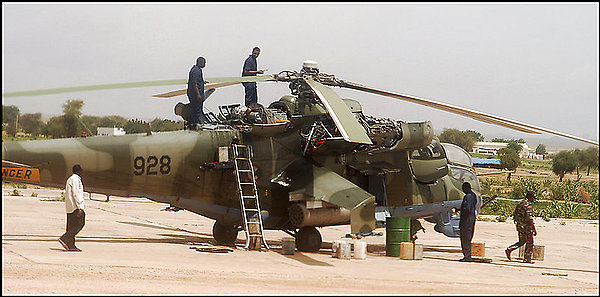Recent photographs purportedly showing Sudanese soldiers in the Darfur region moving containers from a Russian-made Antonov cargo plane onto military trucks reinforce suspicions that Sudan continues to violate a U.N.-imposed arms embargo, the London-based human rights group Amnesty International said.
The photographs, taken in July and released today by the rights group, also purportedly show Russian-supplied Mi-7 and Mi-24 military helicopters in the town of Geneina in Darfur.
 A Russian-supplied Mi-24 helicopter, bearing No. 928, is shown in July at an airport in Geneina, a town in Sudan's Darfur region. Russia provided 12 such aircraft to Sudan in 2005. A Russian-supplied Mi-24 helicopter, bearing No. 928, is shown in July at an airport in Geneina, a town in Sudan's Darfur region. Russia provided 12 such aircraft to Sudan in 2005. |
| Photo Credit: Amnesty International |
Eyewitnesses in Darfur and the International Peace Information Service, based in Antwerp, Belgium, sent the photographs to Amnesty. The images bolster evidence published in a May report by Amnesty that accused Russia and China of having broken the arms embargo, according to a news release from the human rights group.
The Russian-made Antonov, with registration ST-ASA, is listed as operated by Azza Transport, which is under investigation by a U.N. panel monitoring the Sudan arms embargo and arms transfers into Darfur.
One photograph shows an Mi-7 helicopter belonging to the Sudanese air force registered as No. 534. Russia is known to have signed a deal to deliver at least 15 such helicopters in 2005 and 2006, a transaction that should have been suspended after the arms embargo went into effect.
In March 2005, the U.N. Security Council imposed a comprehensive arms embargo on all parties to the conflict in Darfur, including the Sudanese government. A U.N. resolution stipulates that deployments of military equipment and supplies in the Darfur region may be made only if previously approved by the U.N. committee on Sudan sanctions.
The U.N. panel of experts monitoring the arms ban on Darfur has repeatedly said such deployments are a violation of the resolution.
A Russian-supplied Mi-24 helicopter registered as No. 928 and diverted to Geneina's airport from the city of Nyala, Darfur, is shown in another photograph obtained by Amnesty. Twelve such attack helicopters were supplied to Sudan by Russia in 2005.
Amnesty's U.S. director, Larry Cox, said in a statement: "Sudan flaunts its impudence of the U.N. arms and peace agreements by persisting to send arms into Darfur. An embargo is only effective if there are repercussions for defiance."
Cox called on the Security Council to strongly enforce the embargo as soon as possible by placing U.N. observers at all ports of entry. "Darfur is a good place to start," he said.
According to U.N. reports, Sudanese government forces, with support from government-backed Arab Janjaweed militias, carried out aerial attacks on civilians in Darfur at the end of June, with thousands fleeing targeted areas controlled by armed rebel groups.


